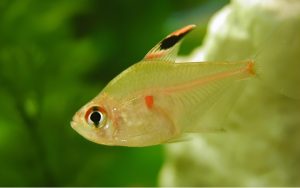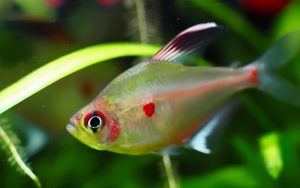Are you looking to keep silver mollies fish but need help figuring out where to start? You’ve come to the right place! Keeping fish healthy and happy requires consistent care and attention—but don’t worry; we’ve got all the information you’ll need to get started.
Fishkeeping can be a difficult and complex hobby, but it’s also among the most rewarding.
If you’re like most fishkeepers, you’ve probably had to deal with at least one sick fish in your tank. And if you’re unlucky, you may have lost a fish or two.
In this article, you’ll learn what it takes to tend to a school of silver mollies so that your efforts will result in solid and vibrant specimens that make for beautiful breeding tank decorations.

This comprehensive care guide will show you how to set up and maintain a healthy freshwater aquarium for your silver molly fish.
You’ll learn everything from choosing the right breeding tank and equipment to feeding and caring for your very popular aquarium fish. Read on for helpful tools, tips, and tricks from experienced aquarists!
Table of Contents
ToggleAre Silver Mollies Schooling Fish?
Yes, silver mollies are schooling fish and tend to display their best colors in a group. Schools of mollies will generally hang together near the surface or bottom of the tank in large numbers.
These peaceful fish prefer shallow waters with plenty of aquatic plants to hide and swim around.
When kept alone, silver sailfin mollies can be shy and stressed; however, when kept in groups, they can become quite active as they chase each other through plants and substrate.
When kept in a single-species tank, these fish will often form tight schools and interact with each other regularly.
This type of social interaction helps reduce stress levels and encourages spawning activity. Mollies are livebearers, meaning they will give birth to fully-formed fry without needing external fertilization.
Silver Molly Scientific name: Silver mollies belong to the species Poecilia latipinna, commonly known as the short-finned molly. As such, these fish should always be kept in schools of at least six individuals.
How Big Do Silver Mollies Get?
How big do silver molly fish get? Molly fish size can vary depending on the types of molly and the size of the tank they are kept in.
However, most mollies stay relatively small—typically between three and five inches long when they reach adulthood.
They may grow slightly larger if given a spacious environment, but this should be avoided as it can lead to aggression within the school.

In general, male mollies also have a modified anal fin called a gonopodium, which can make them appear larger than females.
The silver platinum Lyretail Molly is slightly larger than the silver molly, with males reaching up to seven inches in length.
Mollies can thrive in tanks as small as 10 gallons; however, if you’re planning on keeping more than a couple of these freshwater fish, then it’s best to increase the size of your tank to accommodate them.
What Size Tank Do Silver Mollies Need?
To keep mollies healthy, you’ll need to provide them with a tank that can hold up to 10 gallons of water. This will give them enough space to swim around without feeling crowded.
If you’re going to keep more than six mollies, you’ll need an even larger tank—upwards of 20 gallons to provide enough room for the entire school. dalmatian mollies
A 10 Gallon aquarium is the perfect size to ensure fry has plenty of room and hiding spots with lush vegetation, like Java Fern or Java Moss.
When setting up your aquarium, ensure plenty of hiding places, such as caves or rocks, for the fish to swim in and out of.
A good filtration system is also essential for keeping the water clean and free of waste. You’ll need to perform regular water changes every two weeks to ensure the tank stays healthy.
Finally, be sure to choose an aquarium with ample lighting; Silver mollies are known to be quite sensitive to light and need plenty of it to stay vibrant.
Which Fish Can Live with Mollies?
Silver mollies can be kept with various peaceful community tank mates such as guppies, platies, catfish, and tetras.
When selecting tank mates for your mollies, it’s essential to remember that these freshwater fish are pretty active, so any other species you choose should also have plenty of space to swim and explore.
It’s also best to avoid other livebearers, such as guppies and platies, as they can breed with the Silver mollies and create a hybrid species.
Finally, it’s important to note that silver mollies are tolerant of a wide range of water conditions, so their tank mates should also be able to thrive in similar situations.
What Do Silver Molly Fish Eat?
Mollies are omnivores, so they eat various foods, including flakes, pellets, baby brine shrimp, bloodworms, and other small eats. A good rule of thumb is to feed your molly a varied live food diet that is high in protein.
Keep your Molly Fish happy and healthy with a diet of Brine Shrimp! Quickly produced at home in either live or frozen form, this popular molly fish food source is sure to keep them energized.
It’s also important to feed them small amounts several times a day rather than one large meal, as this can cause digestive problems.
Be sure to remove any uneaten food within two minutes of feeding time—this will help keep the water clean and free of excess waste.
Overall, mollies are hardy fish that can thrive in various aquariums if given the proper care and diet. Their peaceful nature and beautiful coloration make them a great addition to any community tank set-up.
Silver Molly Fish Food list:
- Fine crushed Flake foods
- Pellets
- Live or frozen brine shrimp
- Baby brine shrimp
- Bloodworms
- Vegetables such as broccoli, spinach, and cucumbers (chopped into small pieces)
- Spirulina flake food diet
How Many Mollies Should You Keep Together?
Generally, it is advised to keep mollies in groups of four or more to allow them to socialize and be comfortable. Too few can easily stress adult fish, while too many can cause aggression.
The ideal number will depend on the tank size, average adult fish size, and other factors, such as different species of mollies living together.
When considering how many mollies to keep in a tank, it’s important to remember that these fish are social creatures and require companionship.
If you’re keeping more than one silver molly, ensure there is enough room for them so they can swim freely and form their own schools.
In addition, be sure to provide plenty of hiding spots and decorations, such as rocks or caves, to help them feel secure.
This will also give the mollies a place to retreat if they become stressed or overwhelmed. By providing the right environment, you can ensure your mollies live long and happy lives.
How Many Mollies Can You Have in a 10-Gallon Tank?
The general rule of thumb for stocking a 10-gallon tank with mollies is about five to six fish.
As mollies are social grazers, it’s best to get a few more, so they have company and keep the tank clean.
However, please note that overcrowding is never recommended; monitor your water conditions closely before filling up the tank too much.
Following the 1-inch per gallon rule, 3-inch mollies would be best kept to a trio in a 10 gallons tank; however, if you opt for shorter specimens, four could happily reside there.
Do Silver Mollies Need a Heater?
Yes, Silverfish Mollies need a heater to maintain optimum water temperatures. These tropical fish prefer warm waters (75-82°F) for a healthy environment, and it is recommended that you use an aquarium heater of adequate size for your tank.
Additionally, keeping the water temperature consistent from day to night helps to keep your mollies in good health and adjust better to their new home.
By providing your mollies with a heater and sponge filter, you can ensure they stay healthy and have the best environment possible.
How Do Silver Molly Fish Mate?
Male and female molly mate by a process known as “polyandry,” in which the female mates with multiple males simultaneously.
During this process, she releases her eggs into the water, and then the sperm of these males fertilize them.
After this, the females can carry up to 500 developing embryos for up to 28 days until they are released as tiny fry that can swim away and find their food sources.
How Often Do Silver Mollies Fish Have Babies?
Silver mollies typically have a spawn every 30 days. Each spawn usually contains up to 300 eggs, which will hatch within a few days.
Females can produce new eggs almost immediately after their first spawn, meaning they have the potential to lay hundreds of eggs in their lifetime.
It’s important to note that the fry must be removed from the tank as soon as possible, or they may become easy prey for other fish in the tank.
By providing a thriving environment for your mollies, you can ensure they stay healthy and happy for years.
How Many Babies Do Silver Mollies Have?
Molly fish baby production varies depending on the size of the female molly fish and environmental conditions, but a typical spawn can contain anywhere from 100 to 300 eggs.
The female molly can spawn almost immediately after her first batch of eggs hatches, which means she may have the potential to produce hundreds of fry in her lifetime.
It’s important to note that the fry should be removed from the tank as soon as possible, or they may become easy prey for other tankmates.
Providing an optimal environment ensures that your mollies stay healthy and have the highest chance of successfully breeding molly.
What to Do When Molly Fish Have Babies?
Molly fish babies, or fry, can be a delightful addition to any aquarium. While they are relatively easy to care for, several vital steps should be taken when black molly fish give birth to ensure their safety and promote healthy growth.
First, you must create an ideal environment for your new fry as soon as possible. As soon as the fry comes into contact with air, they become vulnerable targets to other fish and debris in the tank.
To protect them from predators in the aquarium, create hiding places using live aquatic plants or special breeding traps explicitly designed for this purpose.
A key factor is maintaining water quality; keeping nitrate levels low helps prevent infections in the fragile little ones by preventing parasites from establishing themselves on them too early.
Second, you don’t plan on keeping all of your fries. In that case, it is best to start looking for potential buyers before birth so that, if necessary, you have time to prepare holding tanks or bags where overcrowding can be avoided when transporting them home after delivery.
Thirdly, once born, ensure you feed small amounts multiple times a day. To control water quality and keep it stable during feeding periods, add more frequent yet small water changes throughout each day while feeding mollies.
This will help maintain appropriate nutrient levels needed for optimal growth of the fry throughout their development period and removes any poisonous substances which may be present during regular mealtimes.
Finally- providing adequate nutrition is vital! An appropriately balanced diet designed specifically for baby mollies lives up to high energy needs without risking nutritional deficiencies.
So look out for specially formulated feeds on sale near pet fish store that contain higher concentrations of nutrients & vitamins than traditional catfish food.
With such concentrated diets combined with proper filtration systems In place along with recommended tank maintenance cycles, health problems related to issues among newly hatched baby mollies would efficiently dissipate over time
allowing sudden population increases within species boundaries and, strengthening the genetic diversity of entire populations & helping balance biodiversity within local ecosystems.
By following these simple steps, you can provide your baby mollies with a healthy and happy environment where they can
Conclusion
Congratulations on taking the first step towards becoming a silverfish molly owner! These beautiful creatures can make for a rewarding and low-maintenance pet. By following the care guidelines laid out in this article, you’ll be giving your new pet every chance to thrive. In no time, you’ll have a healthy and vibrant community of mollies swimming in your aquarium. Thanks for reading, and good luck!
You might also like
- What Are Black and Yellow Molly Fish? (A Complete Guide)
- Lifespan of a Molly Fish: Expert Tank Set Up & Beginner’s Guide
- Most Popular Types of Mollies Fish to Choose from (Guide)
- Are Black Molly Fish Aggressive? – Yes, or No! (Revealed)
- Why Is My Black Molly Turning White? (5 Reasons & Solutions)
- Molly Fish Pregnancy Cycle: A Complete Breeding (Guide)





